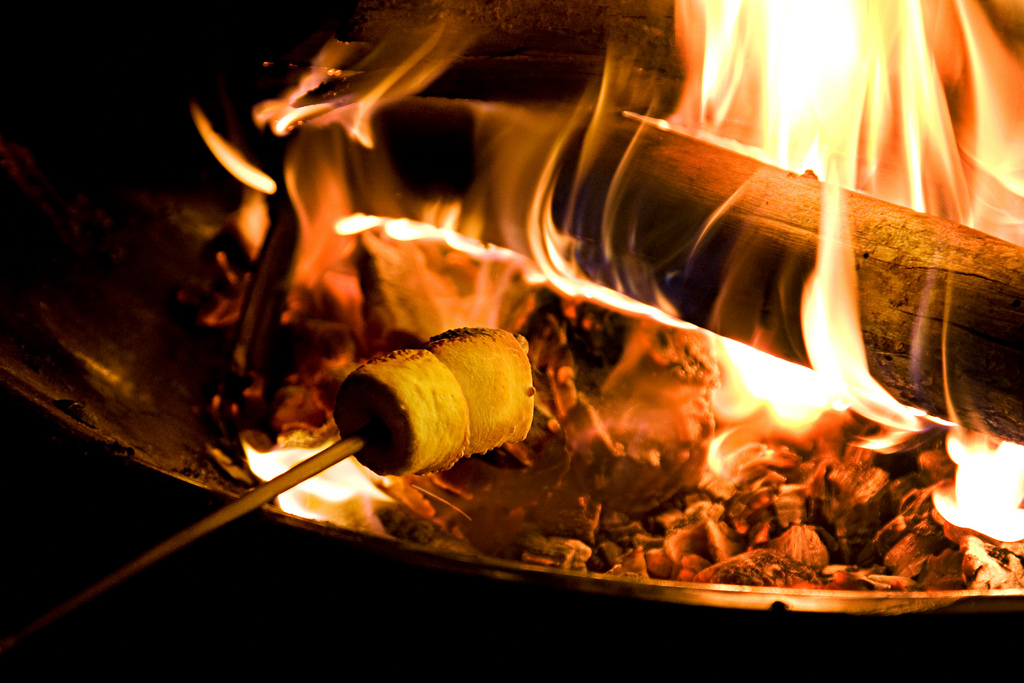Roasting a marshmallow is an art.
Getting the perfect brown crust and soft gooey middle is a trick that takes a bit of practice. Fortunately, I have some experience with this art and can teach it to you. Let’s begin.
First, light your fire.
Get your campfire started. You want the fire to burn down and create hot coals. These pockets of hot coals are the ideal place to roast your marshmallow. This is the key to the whole roasting process. So, create a fire using a log cabin or tee pee approach, but get it going because the burn-down takes the longest time in this process.
Secondly, gather a stick.
For manly-men, go forth and hunt. Find a stick, preferably a green-stick from a branch. Cut it off about arms length or longer.
Now, this is important, make sure your stick it is not too wimpy. A limp stick will bend and you will have no control over your marshmallow . . . because control is everything when roasting a marshmallow.
Without it the marshmallow cannot be navigated into the proper placement over the coals. At best you have asymmetric roasting and at worse your marshmallow flops into the fiery coals and gets dusted black or ignites into a fiery ball.
Do not allow this to happen!
Instead, find a stick that is firm and narrow . . . like an arrow. Get out your knife and trim off the buds and extra branches. Now, sharpen the end like a pencil. Perfect. Nice job! Impale a marshmallow on the end and you, my friend, are ready.
However, the tool of choice could be a store-boughten metal rod with a wood handle. This is ok and does a fine job. I would recommend a long metal rod with one or two ends. The poker should have a handle that protects your hands from heat conducted down the metal rod. Metal pokers are nice because they can be reused indefinitely and cleaned easily with a good burn over the fire after your roasting session. I would make sure that the poker is long enough to avoid getting burned. I have seen some shorties that are simply hard to handle because of knuckle burning. Be careful after roasting to not touch the metal end! This is a source of burns in inexperienced roasters. Please teach your kids this important lesson to not touch the hot end or reach up the metal rod with their hand. Young kids with short hands are notorious for grabbing the middle of the rod to reach out to the marshmallow and learn the hard way.
Once you have a stick, impale the marshmallow lengthwise. You can load up two or more if you wish, but this may make for uneven roasting on the ends, so be cautious.
Thirdly, find those coals
Now, you have the perfect stick and marshmallow impaled lengthwise. Take a step back and look at your fire. The inexperienced roaster jumps in without any thought to placement and indiscriminately starts placing the marshmallow all over the flames in an awkward fashion leading to uneven roasting or a ball of fire. But this is not you. Instead, you plan your route by examining the fire, looking for the perfect placement. You should identify hot coals. They are white and red. These are the best spots. Ideally, a piece of wood is nearby that you can consider placing the mid-body of your poker or stick on to stabilize the rod and rotate around the coals like a routicsierre chicken . . . browning it over and over. A perfect temperature will make the outer marshmallow brown and crusted and the inner soft and gooey.
Watch closely . . . once the marshmallow starts to move on the stick as you are rotating, you know that the center is melting. Give it a few more seconds and slowly remove it from the fire. If it starts to pull off from the stick . . . stay calm and slowly and carefully bring it up and over to your table to prepare your S’more. The loose ones that are on the verge of falling are simply the best. They have a perfectly gooey center. Only with experience will you be able to perfect this timing and repeatedly produce a perfect golden, gooey marshmallow. This is the art of roasting a marshmallow.
What to do if you light your marshmallow on fire
First, stay calm. The marshmallow is already wrecked. No matter how fast you whip it up to your face to blow it out, it cannot be saved. If you are fine with a bit of char, so be it, but you will not be able to save the marshmallow from a burnt head. Some S’more makers prefer the burnt crust. I used to be one of them, but my palette has matured with age and I now prefer golden-brown, which is our goal here.
So, a marshmallow on fire can seem like fun, but is a serious hazard . . . dangerous like gooey hot lava on a stick. At this point you need to stay calm, keep control of your stick and bring it up slowly to your face and give it a firm blow like its your birthday candle. Be careful! Make sure that no one is in close range to get burning marshmallow blown onto them. This simply wrecks the fun around the campfire.
In conclusion.
Roasting a perfect marshmallow is in reach for anyone willing to take the time to practice. So, try it over and over, as practice does make perfect. With time and patience you will go from an inexperienced roaster with coal dusted and burnt marshmallows to golden-brown heavenly beauties as you learn the art of roasting a marshmallow.
